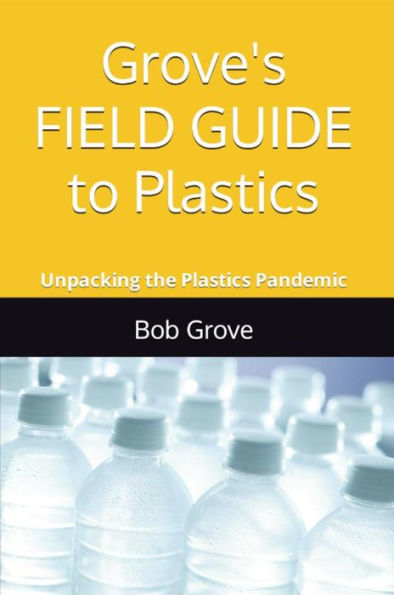Grove's FIELD GUIDE to Plastics
Where's the plastic? It's everywhere. It's on the ground and in our oceans. It's in the air, in our food and in our water. It's in our guts, lungs, and blood streams. It's in placentas and breast milk. We breathe it. We drink it. We eat it and we wear it.
This one really snuck up on us. One moment we're revolutionizing the future and the next we're swimming in a forever land of nondegradable microplastic particles, fibers and the cornucopia of toxic forever chemicals used to make them. Plastics are complex petroleum-based carbon chains with the same climate impacts as burning coal and gasoline, and a centuries-long life span that will leave them clogging our waterways and landfills centuries after we're gone. They never break down into their component chemicals; they just get brittle and break apart into smaller and smaller pieces of – well, plastic.
The health problems of having hundreds-of-millions of tiny plastic particles taking up space inside our bodies is just now being studied. Early research on the chemicals leaching into our bodies from these microplastics suggest links to ADHD, obesity, Alzheimer's and a pantheon of other neurological and hormonal issues.
We can't hide from this modern world of plastic pollution, but we can unpack the problem and choose to avoid the greatest risks. It's our responsibility to make personal choices that assure the health, safety and welfare of ourselves, our communities, our children and future generations.
This Field Guide will help.
"1145131636"
This one really snuck up on us. One moment we're revolutionizing the future and the next we're swimming in a forever land of nondegradable microplastic particles, fibers and the cornucopia of toxic forever chemicals used to make them. Plastics are complex petroleum-based carbon chains with the same climate impacts as burning coal and gasoline, and a centuries-long life span that will leave them clogging our waterways and landfills centuries after we're gone. They never break down into their component chemicals; they just get brittle and break apart into smaller and smaller pieces of – well, plastic.
The health problems of having hundreds-of-millions of tiny plastic particles taking up space inside our bodies is just now being studied. Early research on the chemicals leaching into our bodies from these microplastics suggest links to ADHD, obesity, Alzheimer's and a pantheon of other neurological and hormonal issues.
We can't hide from this modern world of plastic pollution, but we can unpack the problem and choose to avoid the greatest risks. It's our responsibility to make personal choices that assure the health, safety and welfare of ourselves, our communities, our children and future generations.
This Field Guide will help.
Grove's FIELD GUIDE to Plastics
Where's the plastic? It's everywhere. It's on the ground and in our oceans. It's in the air, in our food and in our water. It's in our guts, lungs, and blood streams. It's in placentas and breast milk. We breathe it. We drink it. We eat it and we wear it.
This one really snuck up on us. One moment we're revolutionizing the future and the next we're swimming in a forever land of nondegradable microplastic particles, fibers and the cornucopia of toxic forever chemicals used to make them. Plastics are complex petroleum-based carbon chains with the same climate impacts as burning coal and gasoline, and a centuries-long life span that will leave them clogging our waterways and landfills centuries after we're gone. They never break down into their component chemicals; they just get brittle and break apart into smaller and smaller pieces of – well, plastic.
The health problems of having hundreds-of-millions of tiny plastic particles taking up space inside our bodies is just now being studied. Early research on the chemicals leaching into our bodies from these microplastics suggest links to ADHD, obesity, Alzheimer's and a pantheon of other neurological and hormonal issues.
We can't hide from this modern world of plastic pollution, but we can unpack the problem and choose to avoid the greatest risks. It's our responsibility to make personal choices that assure the health, safety and welfare of ourselves, our communities, our children and future generations.
This Field Guide will help.
This one really snuck up on us. One moment we're revolutionizing the future and the next we're swimming in a forever land of nondegradable microplastic particles, fibers and the cornucopia of toxic forever chemicals used to make them. Plastics are complex petroleum-based carbon chains with the same climate impacts as burning coal and gasoline, and a centuries-long life span that will leave them clogging our waterways and landfills centuries after we're gone. They never break down into their component chemicals; they just get brittle and break apart into smaller and smaller pieces of – well, plastic.
The health problems of having hundreds-of-millions of tiny plastic particles taking up space inside our bodies is just now being studied. Early research on the chemicals leaching into our bodies from these microplastics suggest links to ADHD, obesity, Alzheimer's and a pantheon of other neurological and hormonal issues.
We can't hide from this modern world of plastic pollution, but we can unpack the problem and choose to avoid the greatest risks. It's our responsibility to make personal choices that assure the health, safety and welfare of ourselves, our communities, our children and future generations.
This Field Guide will help.
3.99
In Stock
5
1

Grove's FIELD GUIDE to Plastics

Grove's FIELD GUIDE to Plastics
eBook
$3.99
Related collections and offers
3.99
In Stock

Product Details
| BN ID: | 2940185774618 |
|---|---|
| Publisher: | Wordsinger Publishing |
| Publication date: | 04/01/2024 |
| Series: | Grove's Field Guides , #2 |
| Sold by: | Barnes & Noble |
| Format: | eBook |
| File size: | 284 KB |
About the Author
From the B&N Reads Blog
